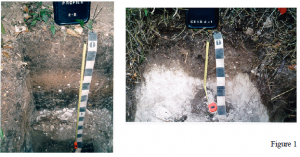Fabián G. Fernández and Dr. Richard E. Terry, Agronomy and Horticulture
New research techniques used in other fields such as agronomy, geophysics, geochemistry, etc. are used by archaeologists at the present time. These techniques have the potential to give useful information about ancient human activities. The chemical and taxonomic analysis of soils can be a useful tool in recognizing different anthropogenic activity areas.
Soil phosphate as an indicator of human activities has been used for many years. At the beginning of the 20th century there were studies conducted of fertility in agricultural land. It was found that high phosphate concentrations were in direct relationship with areas were the Vikings lived (1). Phosphate is one of the main chemical components in bones, human waste, clothing, and food. This chemical is specially useful in archaeological settings because it remains in the soil without being changed over long periods of time. In addition, other chemical analysis such as pH determination, organic matter content, trace metals, and exchangeable cations have been used to determine specific activity areas of ancient people.
The physical properties of soils are also studied to detect rates of soil formation, changes in soil depth, rates of erosion, the type of soil, and the carrying capacity of it. All these features can aid in the interpretation of ancient land use B agricultural practices being one of the most important.
The present study was done in the ancient Classic Maya city of Piedras Negras. The site is situated on the East banks of the Usumacinta River of the Petén rain forest of Guatemala. This is an ancient Mayan center of great importance for archaeological research (2). This area is part of a protected area. Therefore, it has been in its natural conditions since the ancient Maya gradually left the area around 850 AD. One of the main projects during the field season was to determine the soil chemical and physical changes throughout a large valley South of the center area of the ancient site. The main purpose of this study was to find out the type of activity that took place in ancient times. Profile pits were dug across the valley from the steepest slopes down to the bottom of the valley. The first pits were started near the ancient city, and progressively the farther areas from the site were reached. The total length of the study area was approximately 1,500 to 2,000 meters. There was a total of 16 pits dug down to bed rock.
The analyses of the many different horizons found in each soil profile is an ongoing process. Physical determinations of bulk density, texture, and sand size particles were performed. However, the chemical analyses have not yet been finished. At this point it can be deduced that the soils in the steepest parts of the slope appeared to have suffered heavy erosion, probably because of deforestation and agricultural practices that might have taken place in these not so favorable areas once the best land was already under cultivation during the time of the Maya. These soils showed lighter colors and low horizon development. The bedrock was normally found at a depth of 25 to 50 cm from the surface (Fig.1). The bottom floors were deep and some of them showed buried horizons, or in other words, the surface of these soils was covered with soil that was deposited on top of it. These soils were dark and well developed. Most of them had the bedrock at a depth of 150 cm or deeper from the surface (Fig.2). Even though the bottom floors are sufficiently higher than the waters from the Usumacinta river, some of the soil profiles showed evidence of flooding from the river many years ago. Most soils had a silt loam texture, but there were some with clay, clay loam, and sandy loam textures. There was good root penetration in most of the profiles and the structure of the soil was granular in the surface horizons becoming more blocky in the lower horizons. As preliminary information we can say that most of these soils belong to the soil order Mollisols. This soil order is characterized by dark, deep, and fertile surface horizons. They constitute one of the best agricultural soils in the world.
The study of soils in relationship with human activities is giving essential information about the life of the ancient Maya. There are many more tests that need to be performed to come to more conclusive results. I am confident about the future results of this project. It will give information that might help archaeologists to better understand the type of life, organization, and agricultural techniques that this ancient people had.

